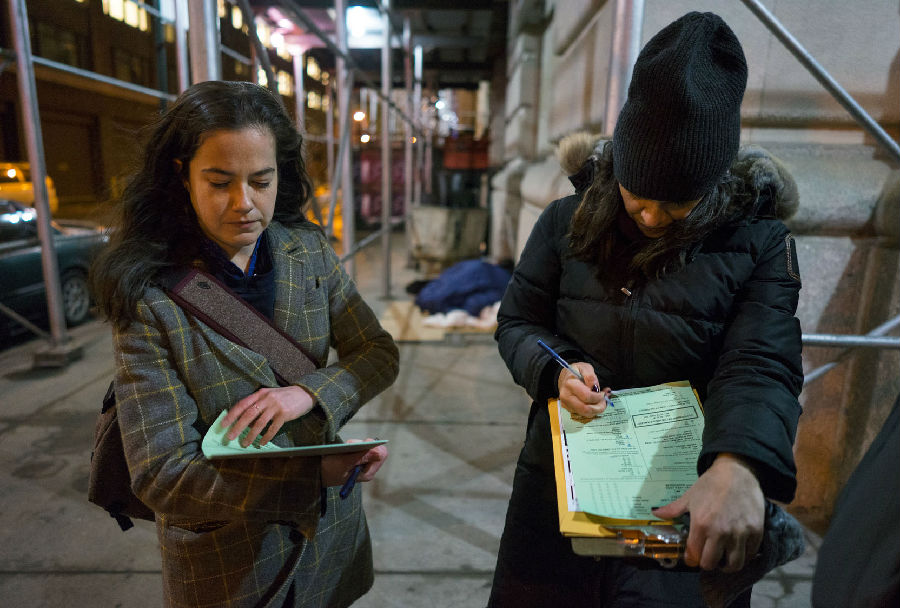The $5 million, 50-employee pilot effort kicked off in August, seeking to assess more than 2,000 people in 90 days.
這項試點工作從8月開始進行,投入資金500萬美元,共有50名員工參與運行,該工作旨在用90天的時間對2000多人進行評估。
Chris Block, the director of coordinated entry for Episcopal Community Services of San Francisco (ECS), a charity spearheading the count,
克里斯·布拉克是舊金山市圣公會社區服務(一個帶頭試行該系統的慈善組織)協調準入項目的負責人,
says his team has spoken to double the number of homeless people he'd anticipated, which has "given us a pretty good baseline of who's the most vulnerable in order to determine housing."
他說他的團隊調查過的無家可歸者數目比他預期的多一倍,“這給了我們一個很好的基準,讓我們知道誰是最需要幫助的人,以此確定住房安排。”
But ONE System faces immense obstacles just getting people to sign up. City employees must gain subjects' trust, learn their real name, and persuade them to join a monitoring system.
但ONE System在讓流浪者注冊參與項目時面臨著巨大的阻礙,員工必須獲得受訪者的信任,知道他們的真實姓名,說服他們加入監控系統。
Participants must sign the program's medical-records privacy protection forms—a tough task for those suffering from mental illness.
參加者必須簽署該計劃的醫療記錄隱私保護表,這對患有精神疾病的人來說是一項艱巨的任務。
To get permanent housing, program members must pass a background check, which can take 45 days and requires an ID card, something that many people living on the street lack.
為了獲得永久性住房,項目成員必須通過背景調查,這可能需要45天的時間,還需要持有身份證,而許多流浪街頭的人并沒有身份證。
People become homeless for a number of reasons that sometimes overlap—mental illness, unemployment, drug addiction—meaning no amount of data crunching can churn out one easy fix.
人們變得無家可歸的原因有很多,有時幾種原因同時存在,比如患有精神疾病、失業、吸毒等,這意味著即使進行再多的數據處理也無法獲得一個簡單的解決方案。
ONE System will also have to combat skepticism about its fundamental creepiness:
ONE System還必須克服人們對該系統抱有的恐懼心態:
If authorities discover drug use or violent crime through the tracking system, for example, could it become a digital policing tool?
如果當權者通過跟蹤系統發現吸毒或暴力犯罪等事件,ONE System會不會成為維護治安的數字化工具?

Block and other authorities say no, but there's no law governing use of the data, so it isn't clear what might happen in such situations.
布拉克和其他權威機構負責人表示不會,但目前沒有管控數據使用的法律,所以還不清楚在這種情況下會發生什么。
Police haven't monitored the system yet, he says, and "no one is trying to purchase that data, either."
布拉克說,警方還沒有監控該系統,“也沒有人試圖購買這些數據。”
Participants can be removed from the system on request, but Block admits the procedure isn't easy.
參與者可以根據要求從系統中將自己的信息移除,但是布拉克承認移除步驟比較繁瑣。
"There's a lot of privacy concerns," he says. "So far those issues haven't been significant, but that doesn't mean they won't come up in the future."
他說:“有很多隱私問題,到目前為止,這些問題還并不顯著,但這并不意味著它們將來不會出現。”
Almost half the city's homeless are already part of the system, which will be fully rolled out in the next few months.
舊金山市幾乎一半的流浪者信息已經存入系統中,該系統將在未來幾個月全面推行。
As of late January, 20 people had been placed in permanent housing, Block says, and 50 more had been helped off the street through counseling or renewed contact with friends and family.
布洛克說,截至1月底,他們已經把20人安置到永久性住房中,還有50人通過咨詢或與其朋友和家人重新取得聯系而告別露宿街頭的生活。
Those relatively modest gains underscore the complexity of the task. Still, Block, a former affordable housing developer, says the goal is to halve the city's homeless population by 2022.
他們取得的些許成果突顯出實施該任務的復雜性,然而,前經濟適用房開發商布拉克表示,他們的目標是到2022年,將舊金山市的無家可歸人口減半。
He expects placements to rise to as many as 90 in the next 90 days. "We'll see a difference on the streets of San Francisco in the next year," he says.
他預計在接下來的90天內,安置人數將上升至90人。他說:“明年,我們將在舊金山街頭看到完全不同的景象。”












